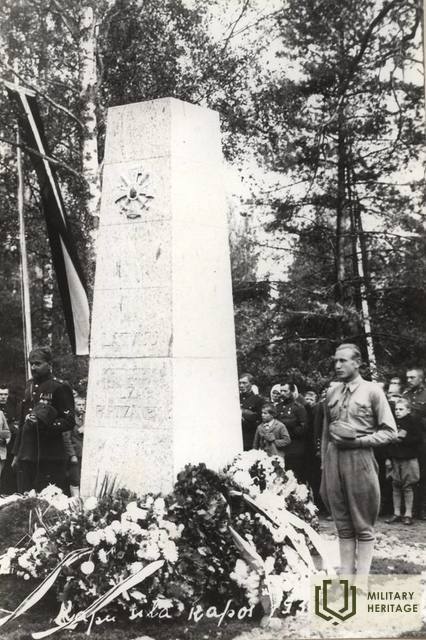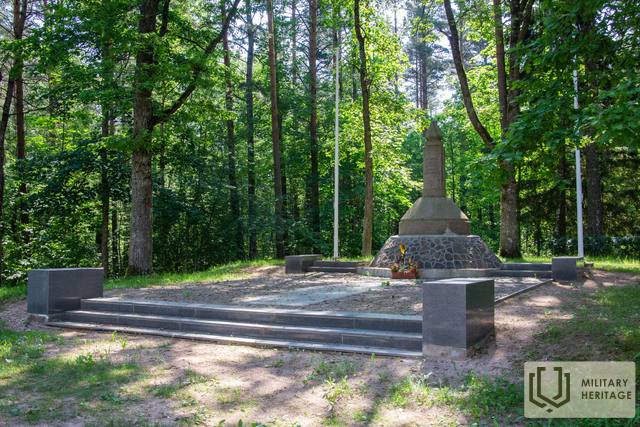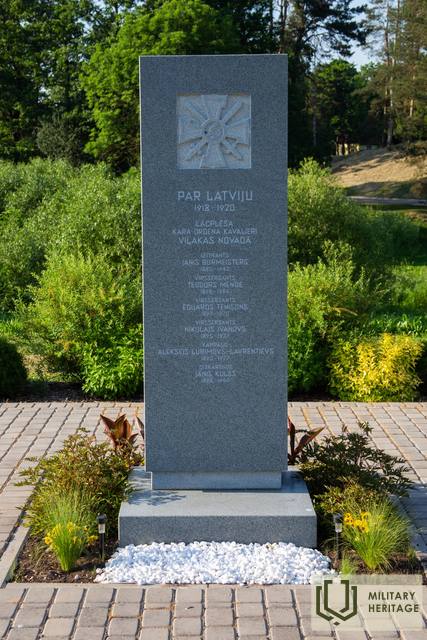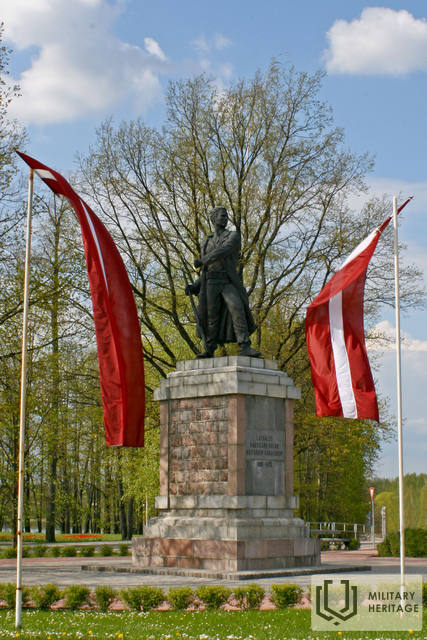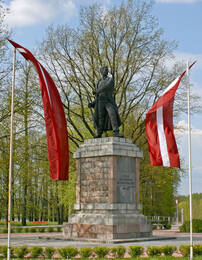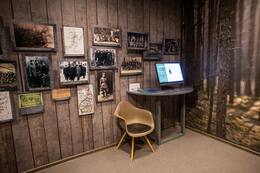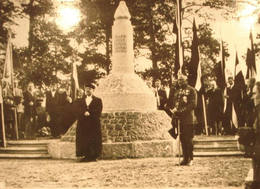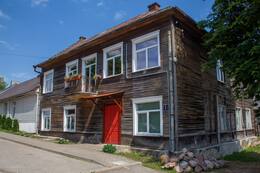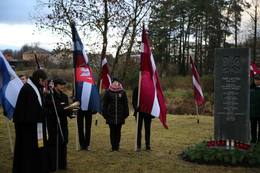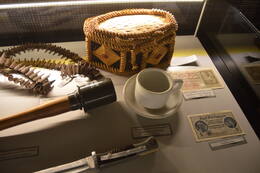Šiaurės Latgalos išlaisvinimas nuo bolševikų
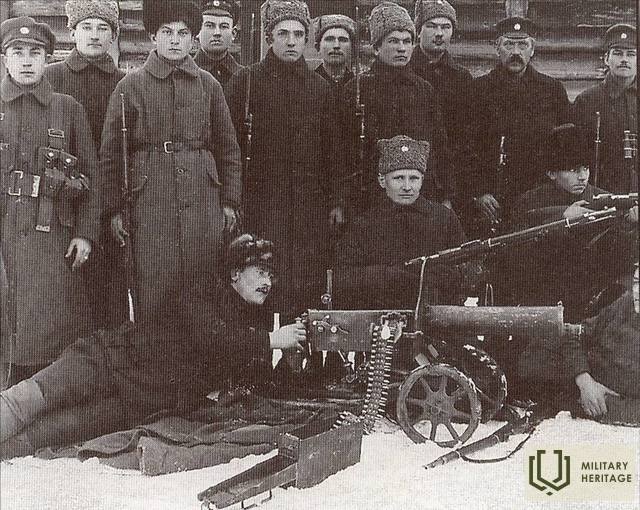
1918 m. gruodžio 1 d. Raudonosios armijos daliniai, sudaryti iš raudonųjų šaulių dalinių, įsiveržė į Latvijos teritoriją. Siekdami apsaugoti savo namus, šeimas, gimtąjį kraštą ir išvengti teroro, Balvių apylinkių vyrai griebėsi ginklų ir patraukė į miškus, prasidėjo pirmųjų „žaliųjų“ grupių formavimasis. 1919 m. pavasarį, paskelbus mobilizaciją, daugelis Balvių apylinkių vyrų laikė nepriimtiną kovą sovietinėje Latvijos armijoje ir prisijungė prie „žaliųjų“ grupių. Buvo suformuotos Balvių, Silakrogo, Rugėjų, Teteru-Dūrupės ir Liepnos grupės. „Žaliųjų“ grupių veikla Balvių apylinkėse suaktyvėjo 1919 m. kovo mėn.
1919 m. gegužę, Latvijos laikinosios vyriausybės ginkluotosioms pajėgoms tęsiant puolimą rytuose, partizanų aktyvumas Balvių apylinkėse sustiprėjo. Iki 1919 m. pavasario buvo susikūrusios kelios partizanų grupės, kiekviena grupė turėjo savo vadą, o tarp atskirų „žaliųjų“ grupių beveik nebuvo jokio bendravimo.
1919 m. gegužės – birželio mėn. Liepnos – Balvų – Rugajų apylinkėse nebuvo nė vienos kariaujančios armijos, neveikė jokios administracinės institucijos. Regiono gynybą į savo rankas perėmė vietos partizanai, sukurdami atramos taškų sistemą nuo Lubano ežero iki Liepnos. Partizanams teko sunki užduotis – išlaikyti apie 50 km ilgio fronto liniją, kuo daugiau įrengiant postus pagrindiniuose keliuose. Gynybai buvo naudojamos natūralios kliūtys – pelkėtos vietovės, miškai.
1919 m. birželio pradžioje „žaliosios“ Rugėjų, Sudarbės, Orlovos, Silakrogo, Balvių, Kupravos grupės susijungė į Balvių partizanų diviziją, kurios vadu tapo Jānis Vīndedzis. Balvių partizanų divizione buvo apie 100 vyrų, o svarbiausius kelius saugojo postai Ruguose, Sudarbėje, Orlovoje, Silakroge, Kupravoje, o ryšius užtikrino apie 30 vyrų kavalerijos divizija, naudojusi savo arklius.
Birželį Balvų partizanų būrys dalyvavo susidūrimuose su priešo žvalgybos grupėmis, neleisdamas Raudonajai armijai grįžti. Susidūrimai įvyko prie Silakrogo, Augustovo, Orlovos, Sudarbės, Kupravos, Pokroto ir Tikainių. Nepaisant nedidelio partizanų skaičiaus, jie beveik visuose mūšiuose įgijo pranašumą, kurį palengvino tiek pelkių ir miškų pažinimas, tiek gyventojų parama.
1919 m. liepos pradžioje Rytų fronto vyriausiasis vadas išleido įsakymą pervadinti Balvų partizanų dalinį į Latgalos partizanų pulką, o jo vadu paskirtas generolas leitenantas Jānis Vīndedzis. Pulkas tapo reguliariuoju armijos daliniu, kurį daugiausia sudarė vietos gyventojai, daugiausia savanoriai, įskaitant vyresnio amžiaus vyrus ir paauglius, peržengusius šauktinių amžių. Liepos pradžioje pulke buvo kiek daugiau nei 700 kareivių, tačiau kovinių dalinių skaičius palaipsniui didėjo, iki spalio mėnesio jau buvo 3 batalionai su 8 kuopomis ir apie 2000 kareivių. Lygiagrečiai su pulko formavimu vyko ir aktyvi kovos veikla. 1919 m. kovos tęsėsi su skirtinga sėkme, partizanai išlaikė užimtą teritoriją. Didžiausi mūšiai vyko prie Stompaki, Kokorevos, Augustovos, Susajų ir Liepnos. Rugpjūčio ir rugsėjo mėnesiais pulko sektoriuje tęsėsi kovos tiek kaip žvalgybiniai susirėmimai, tiek kaip puolimo operacijos.
Spalio mėnesį pulko vadovavimą perėmė kapitonas Jānis Skujiņš. Pulkas plėtė savo teritoriją, atstumdamas Raudonosios armijos dalinius, taip pat turėjo trauktis, palikdamas neseniai išlaisvintas gyvenvietes. Pulko sudėtis padidėjo, nes po srities išlaisvinimo daugelis vietos gyventojų savanoriškai įstojo į Latgalos partizanų pulką, taip pat atvyko savanoriai iš sovietų kontroliuojamų teritorijų, slapta kirsdami frontą.
1920 m. sausio 9 d., 6 val. ryto, vienu metu prasidėjo puolimas visame Šiaurės Latgalos fronte.
Pagrindinė pulko užduotis buvo užimti Pitalovos geležinkelio mazgą, taip neleisdama priešui judėti į pietinę Latgalą, kur puolė dalys Lietuvos ir Lenkijos armijų.
Didžiausius mūšius pulkas kovėsi prie Karsavos, Baltinavos, Augšpilio ir Pitalovos. Įnirtingi mūšiai vyko prie Škilbėnų, Latgalos partizanų pulko 2-asis batalionas puolė Škilbėnų aukštumas, mūšiai tęsėsi kelias dienas, priešininkas buvo 15-osios armijos specialiųjų užduočių pulkas.
Šiaurės Latgalos išlaisvinimas buvo rimčiausias išbandymas Latgalos partizanų pulkui per visą jo kovų istoriją. Pulko kariai, daugiausia vietos gyventojai, puikiai panaudojo savo žinias apie vietovę ir sumaniai taikė partizaninio karo taktiką.
Už didvyriškumą mūšyje 53 pulko kariai gavo aukščiausią vyriausybės apdovanojimą – Lačplėsio karo ordiną. Jų likimai susiklostė skirtingai; sovietų valdžios laikais daugelis buvo įkalinti, ištremti į Sibirą arba emigravę Antrojo pasaulinio karo metu.
Pagerbiant žuvusių karių atminimą, po Nepriklausomybės karo Balvuose, Viljakoje, Baltinavoje, Škilbėnuose, Rugajuose, Tilžoje, Karsavoje, Rītūpėje, Linavos valsčiuje,* Kacėnų valsčiuje* (*dabar Rusijos Federacijos teritorija) buvo pastatyti paminklai ir įkurtos atminimo vietos. Daugelyje kapinių – Bērzkalnės valsčiuje, Priedainės kapinėse, Rugajų valsčiuje, Cepurniekų kapinėse, Garosilu kapinėse, Stāmerės kapinėse, Balvų miesto stačiatikių ir liuteronų kapinėse, Liepnos parapijos kapinėse ir kt. – palaidoti žmonės, kurie savo didvyriškumu ir pasiaukojimu Nepriklausomybės kare prisidėjo prie Latvijos išlaisvinimo.
Balvių apskrities muziejaus kolekcijos medžiaga
Susijusi laiko juosta
Susijusios temos
Susijusios vietos
Paminklas žuvusiems Latgalos partizanų pulko kariams 1919–1920 m.
Latvijos Nepriklausomybės karo (1918–1920 m.) metu Balvių krašte vietos gyventojų iniciatyva buvo suformuotas Balvių partizanų skyrius, kuris netrukus buvo pertvarkytas į Latgalos partizanų pulką.
Pulko paminklo idėja kilo dar 1927 m. 1933 m. buvęs Latgalos partizanų pulko kareivis ir akmenkalys Jānis Pilmanis savo lėšomis pastatė 5 metrų aukščio akmeninį paminklo postamentą. Patį bronzinį paminklą sukūrė menininkas Kārlis Jansons.
Paminklas, skirtas žuvusių pulko karių atminimui, buvo atidengtas 1938 m. rugpjūčio 14 d., dalyvaujant generolui Jāniui Balodžiui. Nors oficialus paminklo pavadinimas buvo „Sargybos partizanas“, netrukus žmonės paminklą ėmė vadinti tiesiog „Balva Stanislava“.
Latviją okupavus SSRS, 1941 m. pavasarį Abrenės apskrities vykdomojo komiteto sprendimu paminklas buvo nugriautas. Aukštas postamentas buvo nugriautas, tačiau pats bronzinis paminklas liko Balvų policijos kieme.
Vokiečių okupacijos metu paminklo postamentas nebuvo restauruotas, tačiau pats bronzinis paminklas buvo pastatytas ankstesnėje vietoje. Po antrojo sovietų okupantų sugrįžimo 1944 m. paminklas buvo visiškai sunaikintas.
Latvijai atgavus nepriklausomybę, Balvų gyventojai rinko aukas Latgalos partizanų paminklo restauravimui. 1993 m. lapkričio 11 d. Balvuose buvo atidengtas restauruotas paminklas, kurį sukūrė menininko Kārlio Jansono sūnus Andrejus Jansonas.
Prie paminklo pjedestalo galo pritvirtinta papildoma atminimo lenta su užrašu „Renovuota taip pat pagerbiant 1940–1954 m. Latgalos nacionalinės laisvės kovotojus“.
Ekspozicija „Šiaurės Latgala kovose už laisvę“ (Ziemeļlatgale brīvības cīņās)
Muziejus įsikūręs Balvų dvaro komplekse, buvusiame dvaro klėties pastate.
Ekspozicija supažindina su Latvijos Nepriklausomybės kovų istorija iš Šiaurės Latgalos perspektyvos, pasakoja Latgalos partizanų pulko kūrimosi ir veiklos istoriją. Čia eksponuojamos anksčiau niekur nepublikuotos nuotraukos ir dokumentų kopijos, įskaitant 1919 m. liepos 5 d. įsakymą dėl pulko suformavimo. Ypatingą ekspozicijos dalį sudaro 1919 m. liepos–spalio mėn. rusų kalba rašyti vidiniai pulko įsakymai. Jie atskleidžia šio vietinio karinio dalinio formavimosi ypatumus – jame kartu kovojo latviai, latgaliai, rusai ir žydai. Tik pulkui tapus visaverte Latvijos kariuomenės dalimi ir jį papildžius mobilizuotiems kariams iš kitų Latvijos regionų, vidiniai dokumentai pradėti rengti latvių kalba. Ekspozicijoje pasakojama apie Šiaurės Latgalos išvadavimo operaciją. 1920 m. sausio 9–15 d. Latvijos kariuomenės Latgalos divizijos vykdytų mūšių metu buvo išlaisvintos Viliakos, Jaunlatgalės ir Karsavos apylinkės. Galima apžiūrėti su šia operacija susijusius eksponatus, įskaitant ir Lat galos partizanų pulko veiklą Karsavos išvadavimo metu.
Paminklas Jaškove Latvijos išsivadavimo kovoje žuvusiems kariams
Įsikūręs kairėje Viliakos–Vientulio kelio atkarpos (P35) pusėje, šalia Jaškovos kapinių koplyčios.
Paminklas Latvijos ir Estijos kariams, žuvusiems Nepriklausomybės kare.
Skulptoriaus Kārlio Zemdegos sukurtas paminklas 1920 m. Jaškove žuvusiems Išvadavimo kare kariams atminti pirmą kartą buvo atidengtas 1935 m. rugsėjo 22 d. Viliakos brolių kapinėse, įkurtose 1929 m.
Laisvės kova prieš Raudonąją armiją Viliakos krašte prasidėjo 1920 m. sausio 9 d., kai Latvijos armija ir Latgalos partizanų pulkas užpuolė miestą. Jose dalyvavo ir Estijos kareiviai. Viliaka buvo išlaisvinta sausio 9 d., tačiau kovos į rytus nuo jos tęsėsi dar kelias dienas. Tiek prieš, tiek po Viliakos išlaisvinimo žuvę kareiviai buvo laidojami įvairiose vietos gyventojams žinomose vietose. Latvijos valstybei stabilizuojantis, pradėta galvoti apie bendrų brolių kapinių įrengimą Viliakoje. Jau 1923 m. lapkričio 18 d., po iškilmingų pamaldų katalikų bažnyčioje, kurias vedė dekanas P. Apšinīkas, didelė procesija patraukė į naujai įkurtas brolių kapines ant kalvos, vadinamuosiuose Jaškovuose – visai netoli Viliakos. Netrukus buvo padėti paminklo pamatai ir pradėtos rinkti aukos paminklui. Žuvusių kareivių kapų identifikavimas užtruko, ir tik 1929 m. lapkričio 3 d. įvyko perlaidojimas būsimose brolijos kapinėse. Jose buvo palaidoti 31 Latvijos ir 14 Estijos kareivių, žuvusių Viliakos apylinkėse. 1935 m. paminklas buvo paruoštas ir iškilmingai pašventintas rugsėjo 22 d.
Iki karo Latvijos nepriklausomybės metais visi svarbūs nacionaliniai įvykiai Viljakos parapijoje buvo susiję su brolių kapais ir šiuo paminklu.
Paminklas buvo sunaikintas pokario sovietmečio metais, tačiau jo granito dalys, nors ir pažeistos, buvo išsaugotos. Paminklas buvo restauruotas 1990 m. lapkričio 11 d. – Lačplėsio dieną.
Privati ekspozicija „Abrenės kambariai“ (Abrenes istabas)
Privati ekspozicija „Abrenės kambariai“ įsikūrusi Viliakos mieste, istoriniame pastate. Iš pradžių šis pastatas stovėjo senosios Marienhauzeno turgaus aikštėje. Vėliau čia veikė butai, biurai, įvairios parduotuvės, o Antrojo pasaulinio karo metais – latvių savigynos štabas, gestapas ir čekistų būstinė. Ekspozicijose pristatomi įvairūs Viliakos ir jos apylinkių istorijos laikotarpiai bei įvykiai nuo 1920 iki 1960 metų – kai miestelis priklausė Jaunlatgalės, vėliau Abrenės apskričiai. Tarp eksponatų – Stompakų pelkės partizanų štabo daiktai, pasakojantys apie nacionalinį pasipriešinimą Latgaloje, taip pat dokumentai ir fotografijos iš Nepriklausomybės kovų laikotarpio. Naujausioje ekspozicijoje lankytojai gali susipažinti su kadaise garsia motokroso trasa „Baltasis briedis“
Atminimo stela Lāčplėsio karo ordino kavalieriams
Įsikūręs šalia Švenčiausiosios Jėzaus Širdies Romos katalikų bažnyčios Viliake.
2017 m. lapkričio 11 d. Viliakos savivaldybėje buvo atidengta atminimo stela Lačplėsio karo ordino kavalieriams. Su Viliakos savivaldybės vardu susiję 28 Lačplėsio karo ordino kavalerių likimai.
Granito stela buvo sukurta įgyvendinant projektą „Prisiminkite Lačplėšį“, skirtą Latvijos valstybės šimtmečiui. Pagerbiant Latvijos Nepriklausomybės kare žuvusius karius, visoje Latvijoje bus įrengta uniformos modelio memorialinė stela. Projekto iniciatorius – Jaunimo gvardijos ir informacijos centras.
Penki Lačplėsio karo ordino riteriai, kurių vardai iškalti memorialinėje steloje, po Nepriklausomybės karo pabaigos gyveno dabartinio Viljakos rajono teritorijoje:
– Jānis Kuļšs buvo jaunas ūkininkas Apsīšuose, Šķilbenų valsčiuje,
– Aleksejus Ľubimovas (Lavrentjevs) gyveno Šķilbėnų valsčiaus Fortepjanovos vienkiemyje, vėliau – Viļakuose,
– Teodoras Mende tvarkė jam priskirtą ūkį ir buvo miškininkas Katleši kaime, Žīgurių valsčiuje,
– Eduardas Tenisonas gyveno Vecumu stotyje, vėliau Čabatrovos kaime ir dirbo „Viliakos“ pašte,
– Šķilbėnų valsčiuje kurį laiką gyveno Jānis Burmeistars po 1928 m.
Viliakos rajono Brolių kapinėse palaidoti 45 kariai, paaukoję savo gyvybes gindami Latviją nuo bolševikų 1920 m. Sausio 9 d. Šiaurės Latgaloje prasidėjo puolimai, ir nepaisant tuo metu vyravusių sunkių oro sąlygų, Viliaka tą pačią dieną buvo išlaisvinta.
Viliakos krašte vykusių Latgalos išlaisvinimo mūšių metu Estijos kareiviai petys į petį kovojo su Latvijos armijos kareiviais ir partizanais prieš Raudonąją armiją. Daugelis jų paaukojo savo gyvybes už laisvą Latviją.
Viliakos muziejus
Viliakos muziejus įsikūręs dviejuose pastatuose – 1913 m. statytuose miestelio kultūros istorijai svarbiuose katalikų parapijos namuose ir buvusiame kapucinų vienuolyne, kurio rūsiai glaudžiai susiję su nacionalinių partizanų judėjimu Stompakuose ir sovietų čekistų veikla. Žmonės prisimena, kad šiuose rūsiuose buvo laikomi ir kankinami žmonės. Senajame muziejaus pastate įrengtos kelios ekspozicijos. Viena jų pristato 1920 m. laisvės kovas Šiaurės Latgaloje, Antrojo pasaulinio karo įvykius – žydų holokaustą Viliakoje ir informaciją apie sušaudytas šeimas. Daugiau apie kiekvieną šeimą galima sužinoti pagal gyvenamosios vietos adresą.
Ekspoziciją papildo informacija apie nacionalinių partizanų judėjimą Stompakuose – įvairūs eksponatai: nuotraukos, daiktai. Muziejaus lankytojai gali susipažinti su karinio paveldo vietomis Viliakoje ir jos aplinkinėse vietovėse, pavyzdžiui, kovotojų už Laisvę paminklu Jaškove, kuris sovietmečiu buvo nugriautas ir atstatytas 1990 m., stela, skirta Lačplėsio karo ordinu apdovanotiesiems. Muziejaus ekspozicijoje girdisi Antrojo pasaulinio karo lėktuvo garsas, kaip priminimas apie netoli Viliakos buvo vokiečių aerodromas „Luftwaffe“. Muziejuje galima susipažinti su prisiminimais apie Antrojo pasaulinio karo įvykius Viliakoje ir gauti informacijos apie vokiečių karo belaisvių stovyklą Račuose.




